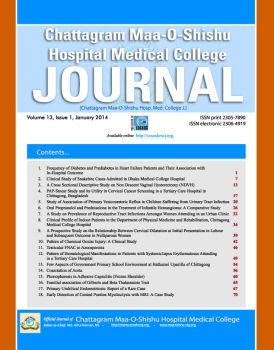Clinical Study of Snakebite Cases Admitted in Dhaka Medical College Hospital
DOI:
https://doi.org/10.3329/cmoshmcj.v13i1.19410Keywords:
Snakebite, reptilesAbstract
Background: Snake bite is an important health hazard which may lead to fatality in rural areas of Bangladesh. An epidemiological study estimated the incidence of snake bite in Bangladesh about 8,000 per year with 22% mortality. In majority of cases the victims die before entrance to hospital because of their treatment seeking behavior from Ohzas. Present study is to see the clinical profile of snake bite cases admitted in Dhaka Medical College Hospital and also to find out problems in diagnosis and management and outcomes.
Methods: Fifty patients of snake bites treated in Dhaka Medical College Hospital, Dhaka, Bangladesh between July 2005 and December 2006 were studied. A questionnaire, containing information on bite, physical examination and identification of snake brought was used.
Results: Among the patients venomous snake was 6 (50%) with cobra and 6 (50%) with suspected krait bite. Males were bitten more frequently than females 42(82%) versus 9(18%). Regarding occupation, 28 (56%) was farmer. Majority 37(74%) came from rural areas. Highest number of bite occurred in evening 20(40%). Most snake bite occurred during rural foot walking (30%) followed by sleeping (14%).Total 54% of bite occurred during outdoor activities. Most common site of bite is lower limb 35(70%). Tight tourniquet used in 45(90%) cases and in 8(16%) cases limb was immobilized. Twenty eight (56%) of the patients received treatment from Ohzas. All venomous bites (12) presented with features of neurotoxicity with local envenoming in 6(50%) cases. In 6(50%) cases there were only neuroparalysis. Four (33.34 % of venomous snake) patients required respiratory support and 10(83% of venomous bite) patients required antivenom. There were no anaphylactic reactions and only 2 patients suffered pyrogenic reaction. The outcome was excellent with only one death and only one case of residual effects.
Conclusion: To develop an appropriate prevention and control strategy, reliable and timely information has a crucial role. A functional mechanism should be developed to gather information not only about the cases and deaths but other aspects of the snakebite epidemiology.
Downloads
289
562
Downloads
Published
How to Cite
Issue
Section
License
Authors of articles published in CMOSHMC Journal retain the copyright of their articles and are free to reproduce and disseminate their work.
A Copyright and License Agreement -signed and dated by the corresponding author on behalf of all authors -must be submitted with each manuscript submission.

